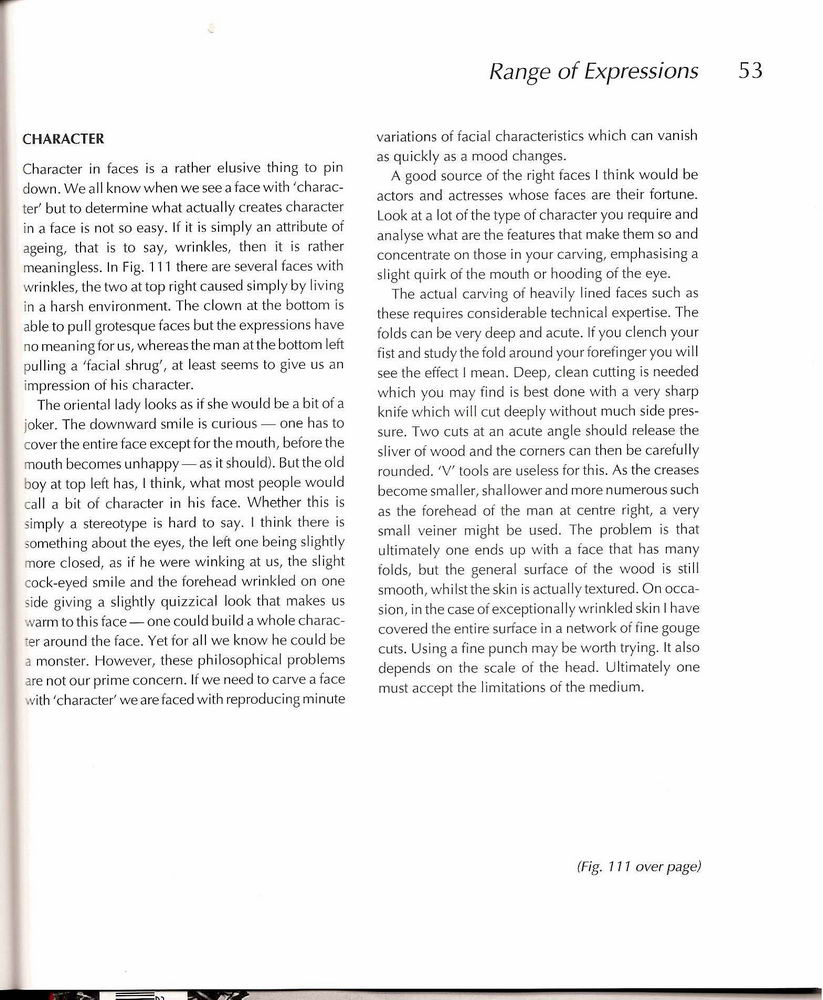carvingúceS

RangÄ™ of Expressions
CHARACTER
Character in faces is a rather elusive thing to pin down. We all know when we see a face with 'character' but to determine what actually creates character in a face is not so easy. If it is simply an attribute of ageing, that is to say, wrinkles, then it is rather meaningless. In Fig. 111 there are several faces with wrinkles, the two at top right caused simply by living in a harsh environment. The clown at the bottom is able to puli grotesque faces but the expressions have no meaning for us, whereas the man at the bottom left pulling a 'facial shrug', at least seems to give us an impression of his character.
The oriental lady looks as if she would be a bit of a joker. The downward smile is curious — one has to cover the entire face except for the mouth, before the mouth becomesunhappy — as it should). Buttheold boy at top left has, I think, what most people would cali a bil of character in his face. Whether this is simply a stereotype is hard to say. I think there is something about the eyes, the left one being slightly morę closed, as if he were winking at us, the slight cock-eyed smile and the forehead wrinkled on one side giving a slightly quizzical look that makes us warm to this face — one could bu i Id a whole character around the face. Yet for all we know he could be a monster. However, these philosophical problems are not our prime concern. If we need to carve a face with 'character' wearefaced with reproducing minutę variations of facial characteristics which can vanish as quickly as a mood changes.
A good source of the right faces I think would be actors and actresses whose faces are their fortunÄ™. Look at a lot of the type of character you require and analyse what are the features that make them so and concentrate on those in your carving, emphasising a slight quirk of the mouth or hooding of the eye.
The actual carving of heavily lined faces such as these requires considerable technical expertise. The folds can be very deep and acute. If you clench your fist and study the told around your forefinger you will see the effect I mean. Deep, clean cutting is needed which you may find is best done with a very sharp knife which will cut deeply without much side pres-sure. Two cuts at an acute angle should release the sliver of wood and the corners can then be carefully rounded. 'V' tools are useless for this. As the creases becomesmaller, shallowerand morę numerous such as the forehead of the man at centre right, a very smali veiner might be used. The problem is that ultimately one ends up with a face that has many folds, but the generał surface of the wood is still smooth, whilst the skin is actually textured. On occa-sion, inthecase ofexceptionally wrinkled skin I have covered the entire surface in a network of fine gouge cuts. Using a fine punch may be worth trying. It also depends on the scalę of the head. Ultimately one must accept the limitations of the medium.
(Fig. 111 over page)
Wyszukiwarka
Podobne podstrony:
carving?ce6 3 6 RangÄ™ of Expressions SADNESS These two studies, Figs 75 and 77, ar
carving?ce9 RangÄ™ of Expressions 39 Figs 80-81 ANGER Figs 80 and 81 show the face of aggression in w
carving?ceQ RangÄ™ of Expressions 51 Fig. 107 WORKING FACES Figs 105 and 106 showin
carving?ce0 3 O RangÄ™ of Expressions HAPPY Referring now to the same people smilin
carving?ce1 RangÄ™ of Expressions 31
carving?ce3 RangÄ™ of Expressions The young boy, Figs 68 and 69. is a natural smiler. Notice t
carving?ce5 RangÄ™ of Expressions 35
carving?ceA RangÄ™ of Expressions 41 Fig. 84
carving?ceI RangÄ™ of Expressions 49 Figs 98-99 Fig. 100
carving?ceP 5 O RangÄ™ of Expressions DETERMINATION Fig. 101 depicts the Gallic war
carving?ceR 5 2 RangÄ™ of Expressions Figs 109-1 W expect on an older person. This
carving?ceU RangÄ™ of Expressions SUBTLE EXPRESSIONS if expressions must be obvious and unambiguous,
więcej podobnych podstron